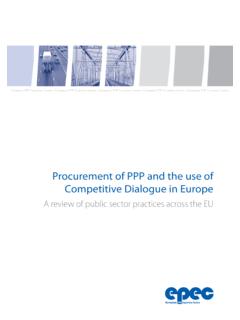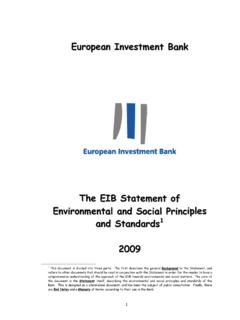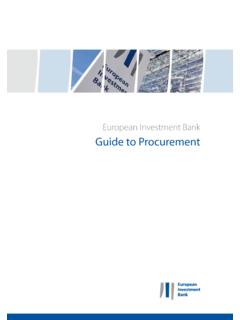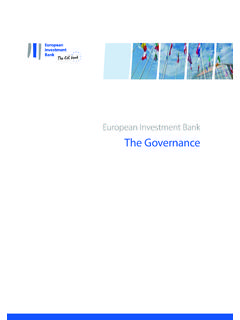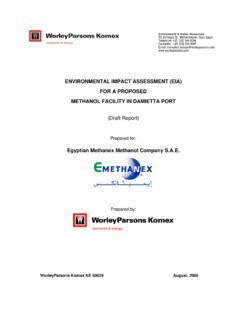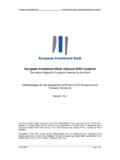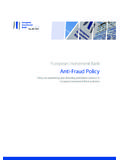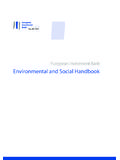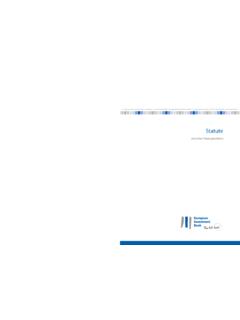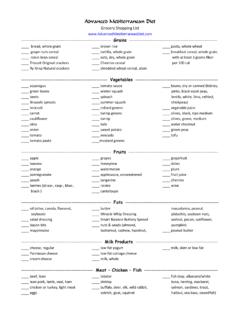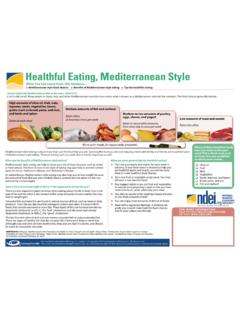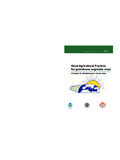Transcription of Feasibility Study for the Mediterranean Sea Maritime ...
1 Fa c i l i t y fo r Eu ro - M e d i te r r a n e a n I nve s t m e n t a n d Pa r t n e r s h i p Fa c i l i t y fo r Eu ro - M e d i te r r a n e a n I nve s t m e n t a n d Pa r t n e r s h i p FEMIP. Executive Summary of the Final Report Feasibility Study for the Mediterranean Sea Maritime Development Cooperation Framework Contract Beneficiary 2009. EuropeAid/127054/C/SER/multi Lot N 2: Transport and Infrastructures Feasibility Study FOR THE Mediterranean SEA Maritime . DEVELOPMENT COOPERATION. Contract nr TA2010049 RO FTF. Beneficiary Country: FEMIP Countries Executive Summary of the Final Report Report date: 16/05/2012. This project is funded by A project implemented by the European Investment Bank Parsons Brinckerhoff Consortium Feasibility Study FOR THE Mediterranean SEA Maritime DEVELOPMENT COOPERATION. Contract nr TA2010049 RO FTF. Executive Summary Executive Summary of the Final Report Report date: 16/05/2012.
2 Framework Contract Beneficiary 2009. EuropeAid/127054/C/SER/multi Lot N 2: Transport and Infrastructures Feasibility Study FOR THE Mediterranean SEA Maritime DEVELOPMENT. COOPERATION. Contract nr TA2010049 RO FTF. Beneficiary Country: FEMIP Countries The Study / technical assistance operation is financed under the FEMIP Trust Fund. This Fund, which was established in 2004 and has been financed to date by 16 EU Member States and the European Commission, is intended to support the development of the private sector via the financing of studies and technical assistance measures and the provision of private equity. The authors take full responsibility for the contents of this report. The views expressed in this document are purely those of the author and may not, in any circumstances, be interpreted as stating an official position of the EIB, the European Commission or IMO. The EIB, European Commission and IMO do not guarantee the accuracy of the information included in this Study , nor does it accept any responsibility for any use thereof.
3 Reference herein to any specific policy proposals or otherwise, does not necessarily constitute or imply its endorsement, recommendation, or favouring by the EIB, European Commission or IMO. Framework Contractor: Parsons Brinckerhoff Consortium Page i Feasibility Study FOR THE Mediterranean SEA Maritime DEVELOPMENT COOPERATION. Contract nr TA2010049 RO FTF. Executive Summary Contents 1 A new vision on Maritime cooperation and development 1. 2 Key issues addressed 1. Investments in Maritime infrastructure 1. Maritime surveillance, safety & the environment 1. Social aspects and training 2. 3 A concrete approach to a modern vision 2. Summary of the results 2. Improving the image of the Maritime sector 2. Improving management and communication, coordination and cooperation 3. Creating employment 3. Training and expertise building 3. Environmental protection 3. Surveillance (safety and security) 4. Integrated governance 4.
4 4 A new instrument to support a new policy 4. Governance of the MIF-M 5. Funding 5. Operational objectives 5. Improving information management 5. Improving regional cooperation 6. Addressing the need for efficient communication 7. Supporting cross-border investments and regional infrastructure developments 7. 5 Final conclusions 7. Framework Contractor: Parsons Brinckerhoff Consortium Page ii Feasibility Study FOR THE Mediterranean SEA Maritime DEVELOPMENT COOPERATION. Contract nr TA2010049 RO FTF. Executive Summary 1 A new vision on Maritime cooperation and development To address the many issues related to improving Maritime cooperation and development, the European Investment Bank (EIB) financed through the Facility for Euro- Mediterranean Investment and Partnership (FEMIP) Trust Fund the Feasibility Study for the Mediterranean Sea Maritime Development Cooperation , which started in February 2011.
5 The International Maritime Organisation (IMO) and the European Commission (Directorate General for Maritime Affairs and Fisheries - DGMARE as lead service) gave full and active support to the Study . The global objective of this assignment is to contribute improving the integration of Maritime policies and the dissemination of investment best practices in the Mediterranean , by providing a common way forward for the cooperation of the EIB, the EC and IMO. The specific objective of this assignment is to provide a Feasibility Study , which identifies and links in a single report some of the key issues for the success of the Mediterranean Sea Maritime Development cooperation project. The principal concern of the Feasibility Study has been to find ways to balance the needs relative to using the economic potential of the Mediterranean Sea with the growing pressure on the marine ecosystem by bridging the fragmentation across the range of Maritime sectors and actors.
6 2 Key issues addressed The Feasibility Study acknowledges in its approach the Integrated Maritime Policy (IMP) vision that considers the sea as a fragile economic area , where increased economic Maritime activity and environmental protection have to go hand in hand and can have a symbiotic relationship as long as proper governance and crosscutting mechanisms are in place. Investments in Maritime infrastructure International collaboration will continue for the development of terminals and ports. At the same time, the growing focus on the sustainable use of the sea and its resources will redirect efforts and investments towards actions to safety, security, alternative (clean) energy, environmental protection, employment, social conditions, quality of performance, sustainable use of sea resources, etc. More resources will have to be made available for developments in the fishing industry, the ship repair sector, offshore activities (both oil and gas as renewable and clear energy), safety and security as well as environmental protection infrastructures, equipment and services, to name only the most important ones.
7 Maritime surveillance, safety & the environment According to the Secretariat of the Union for the Mediterranean , there were 625 traffic accidents recorded between 1997 and 2009 leading to a spill of oil and/or hazardous and noxious substances. Protection and surveillance of this dense and rapidly growing Maritime traffic is thus a key priority. Coastal States monitor Maritime traffic and protect the traffic from various threats; deploy the necessary means of relief near risk areas and take measures to minimise the consequences of possible incidents via the development and maintenance of emergency plans. Much has been achieved in the Mediterranean basin to improve Maritime surveillance and control, in particular via important initiatives such as the SafeMed project. In spite of important progress made in particular in the field of surveillance, the MPC will need more concrete and better targeted interventions to align the MPC with international practices in the other domains for safe traffic and environmental prevention and incident response, including systems to facilitate communication and information exchange.
8 Framework Contractor: Parsons Brinckerhoff Consortium Page 1. Feasibility Study FOR THE Mediterranean SEA Maritime DEVELOPMENT COOPERATION. Contract nr TA2010049 RO FTF. Executive Summary Social aspects and training A career as a seafarer is in theory attractive, given that the Maritime sector is confronted with a growing lack of candidates to meet present and future demand. But the employment opportunity should not be overestimated for several reasons. Stimulating employment of a career as a seafarer for citizens in the MPC is difficult at national level as well as in the international market. At national level, opportunities are limited because the number of commercial vessels navigating under the national flag of MPC is small and fishing fleets are decreasing due to diminishing sector activities. The revival / expansion of the national fleets and improving Flag State performance could contribute to creating employment at national level but the effects on employment will remain moderate as an increasing number of Administrations outsource Flag State obligations to Recognised Organisations.
9 Other employment generating initiatives at national level with better success perspectives include the rehabilitation, modernisation and expansion of the national fishing industry; the development and expansion / modernisation of shipyards, expanding and developing vessel-based services that will increase the need for seafarers (deep-sea search and rescue, ship supply and waste collection services in ports, supply and transport services to rigs and other installations at sea, etc.). Improving the access for MPC candidates in international markets should be pursued via coordinated and simultaneous initiatives at regional level. Dissemination and image building campaigns should be the first step in an effort to increase employment of MPC candidates in the international market, highlighting the quality and availability of trained and certified seafarers and other personnel, including highly specialised engineers.
10 3 A concrete approach to a modern vision Summary of the results The key conclusions from the Feasibility Study were that: Infrastructure investments could be more oriented to non-traditional infrastructure due to the growing role of the private sector in the Maritime sector. Focus could be on Maritime logistics efficiency improvements (hinterland connectivity, logistics centres, port community systems, etc.) in addition to terminals and ports where an identified need remains. Surveillance systems are widely introduced, also in the MPC, and now need to be inter- connected and their functioning integrated. In terms of safety and environmental protection, accurate and up-to-date information is urgently needed to outline technical and financial assistance to develop mandatory facilities in the MPC, lagging in this field far behind the EC. Mediterranean coastal states. Social conditions and training transform rapidly.
